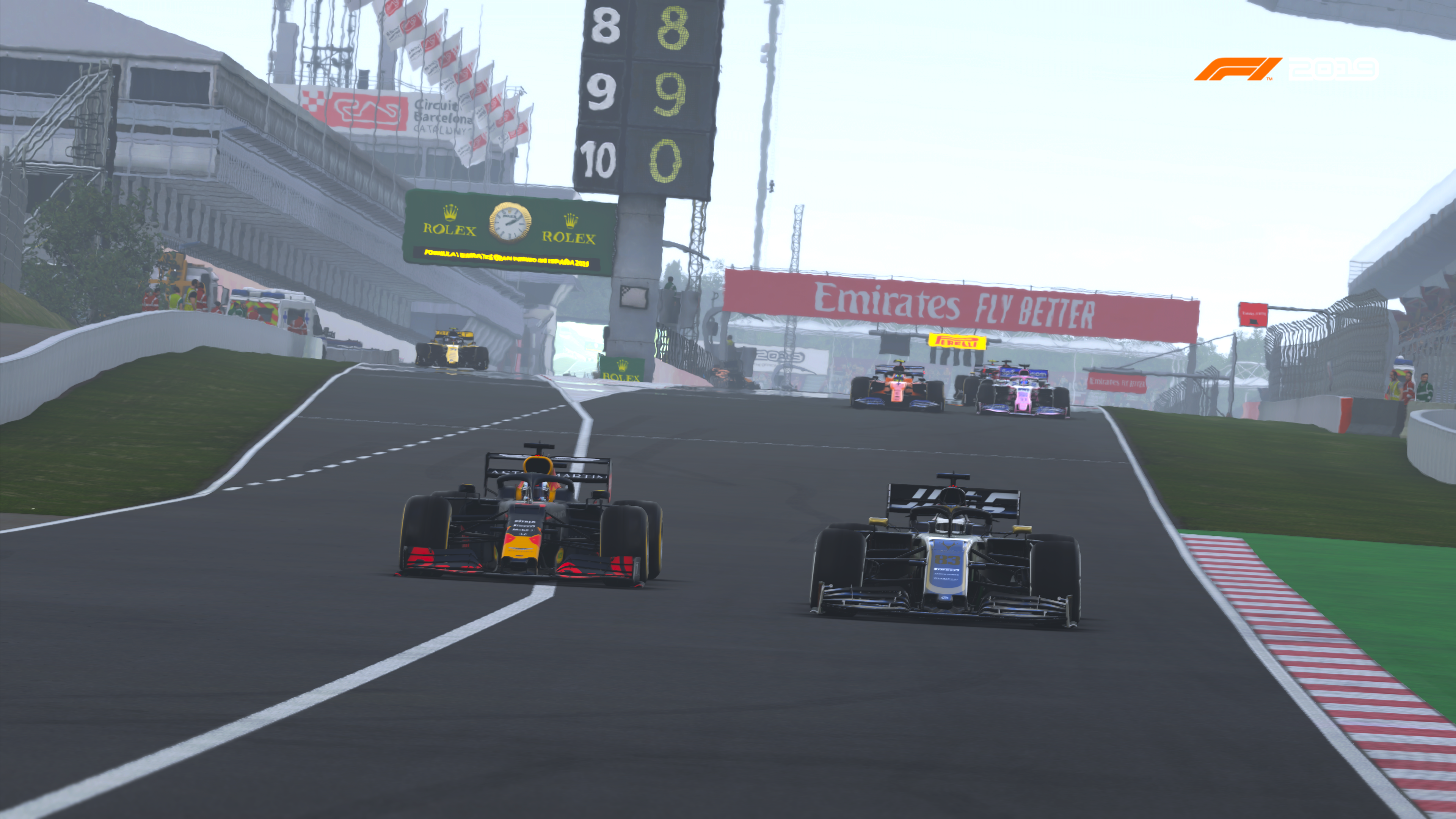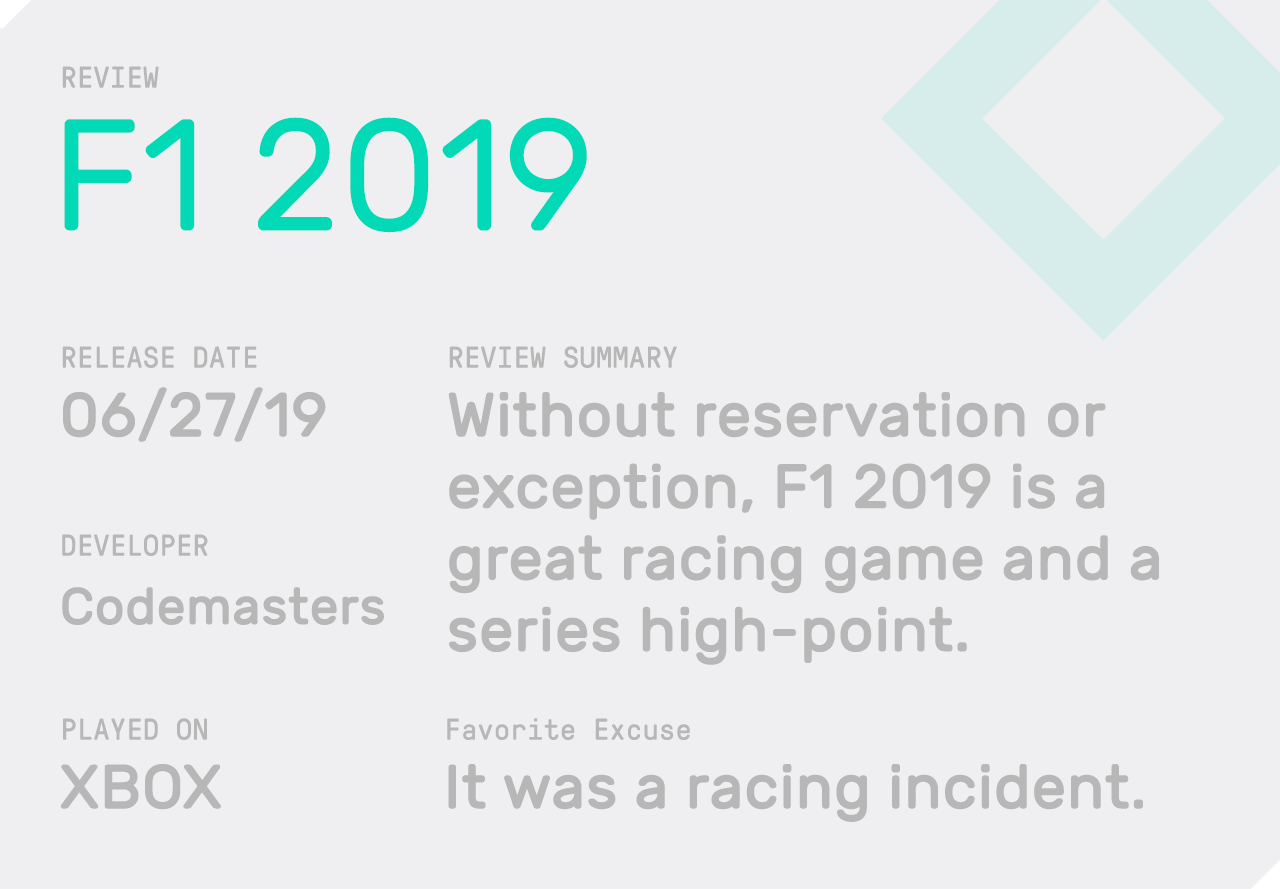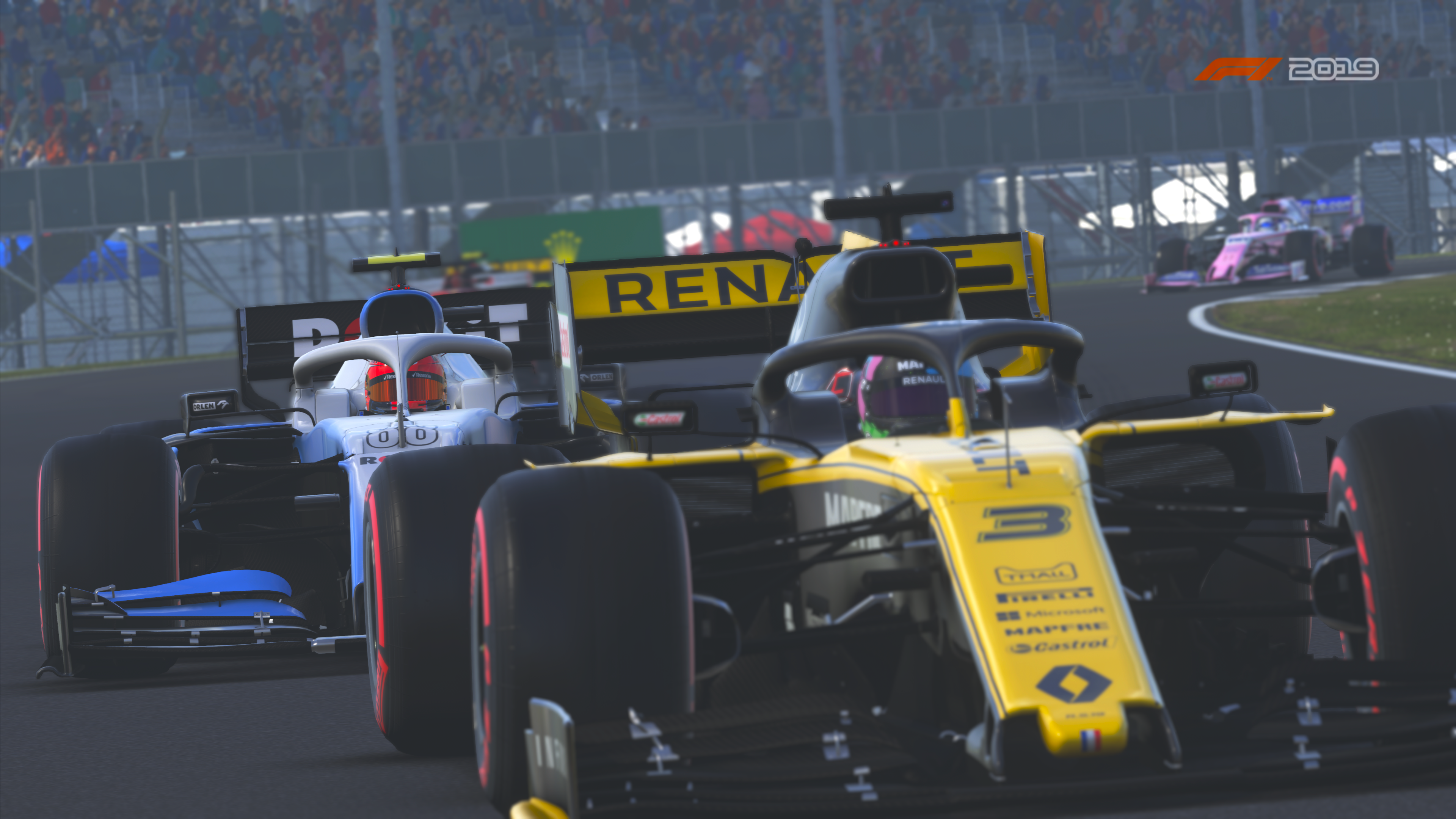‘F1 2019’ Knows That Good Fights Make the Best Racing
Credit to Author: Rob Zacny| Date: Mon, 15 Jul 2019 20:35:10 +0000
Racing games can be meditative. I’ve spent countless hours doing timed laps on an empty track, mind almost completely blank as I operate on pure muscle memory as I dance with a car through familiar steps.
F1 2019 is not that kind of racing game. If the comparison between F1 and flying fighter planes is an old and trite one, it is nevertheless the most appropriate one I can make. It is a game of automotive combat tactics, defensive and offensive weapons, and big-picture strategy.
The star of F1 2019 is its simulation of the turbo-hybrid V6 engine that powers all the cars on the grid. A fussy marvel of engineering, the turbo-hybrid achieves incredible power when both the engine is at its maximum RPMs and the car’s battery is supplying high-wattage. The catch is that the battery will run itself dry in just a couple minutes, but recharges via captured thermal energy from the exhaust and captured kinetic energy from the action of the brakes. In F1 2019, this comes to life via a complex and ever-changing balancing act. Turn up the power on the battery, you shorten its life, but turn it down, the slower you go. The harder you brake, the faster you’ll build charge back up on the battery, but the more your tires wear out, meaning you’ll have to go slower and maybe even stop for new ones.
Now keep all of this in your head as your rocket toward a wall at 192 MPH with another driver between you and the turn you need to make.

Most of these systems existed in last year’s game but it feels like driver AI took a major step forward in this year’s edition, and made clever optimization and strategizing even more important than it was before. Where last year I was mostly able to alternate between high, medium, and low power settings every few laps, this year I find myself snapping through submenus on almost every straight. When another driver is nipping at your heels and threatening to draft past you while your battery is low, sending an enriched fuel mix to the engine might be the thing that saves your position long enough for the battery to fill back up. It might also make sense to punish your tires and mash the brakes heading into the corner, as all that kinetic energy rushes back into the electric system.
If this all just sounds like more buttons to press, rest assured that they all have fascinating effects on how you should drive. That zen state so familiar from other racing games, where you lapse into a steady rhythm, is replaced here by constant decision-making. Every lap is different based on what you want to be doing and the overall state of your tires and equipment. Driving a long race (and few racing games so richly reward running 50% length or greater races) is a restless, almost experimental activity as you chase an ever-moving target of optimal driving.
But when your overall race strategy has worked out, and you’re on the right tires at the right moment, and you’ve got a full charge of battery and over a lap’s worth of extra fuel, F1 2019 feels truly heroic. Making the most of those brief windows when you will have more power than ever and better grip than ever is both demanding and thrilling as the car positively catapults itself down straights and slices through corners, seeming almost to pull its competitors closer as if they were attached to an invisible pulley system in your front wing.

Actually passing them is another matter. It used to be pretty simple to overtake AI drivers: Dive inside them at a turn and just force them to give you space. But they will absolutely take you out if you try bush-league tactics like that now. This is just one way that I’ve noticed more interesting and varied driver behavior from my AI competitors than in past years. They are still good at avoiding foolish collisions, but they’re no longer so collision-avoidant that they’ll let you bully them around the track. I have been surprised at how willing they are to touch wheels through a turn, or force you onto the grass if you’re trying to pass them on the outside of a turnt. Not universally—they’re not driving like jerks—but they’re assertive in a way I usually don’t encounter in a racing game. If you don’t have a dominant advantage over them that will make passing a breeze, you really do have to be patient and wait for the right moment to attack.
Dominant advantages also seem harder to come by in this game. The F1 series has always been a bit idealized in its vision of F1, but the handling qualities of the respective cars still seem muted here. The Haas team has none of the catastrophic tire temperature issues that have ruined their season, and the notoriously twitchy and uncertain Williams is pretty easy to find consistent pace with. The position of F1 2019 seems to be that there really are no bad cars, just some markedly better ones. The dominant Mercedes, for example, feels like it’s an entire difficulty level down from the rest of the field, hugging corners perfectly and wearing away its tires in a predictable, gradual fashion.
The lack of distinctiveness feels like it dogs the classic F1 cars just a bit as well. Perhaps the character of each car is more pronounced if you’re playing with wheel and pedals (I played on the Xbox One X with a gamepad), but the vintage racers you find in games like Project CARS seem livelier and more varied than the roster of F1 2019. More robust historical racing options seem like a great direction for this series to continue to evolve in, but right now the mode and the handling models both seem a bit perfunctory.

Far more fully-featured is the implementation of the “minor league” series, Formula 2. You can race the complete 2018 Formula 2 season (where a lot of current drivers were drafted from) and the F2 cars are a fun change of pace. Cruder and simpler than their F1 counterparts, they are at once more forgiving but also trickier. They feel like old race cars more than the vintage cars, even: spike the throttle in an F2 car and it probably won’t completely spin you out, but it will fishtail wildly and send you into a harrowing and frantic recovery. A “spec series” where all the cars are identical, the F2 season is a further showcase of the tremendous AI. Wheel-to-wheel racing is more common and the duels longer-lived in F2 than in F1, so it’s a great new option for players who just want a straightforward, cutthroat battle between drivers.
F2 is also the stage for the introduction of F1 2019’s career mode, which has a story this time around. In earlier games you basically just created an avatar and started driving for one of the more hopeless teams in F1, slowly working your way up to more prestigious outfits like Ferrari or Red Bull. This time around, you begin your career in Formula 2, in the midst of a friendly rivalry with your fictional teammate, the affable and serious Lukas Weber, and a more combative rivalry with the arrogant, sneering, and also fictional Devon Butler.
Like story modes you find in, say, Madden or FIFA, you play key, dramatic moments in your career rather than entire races or seasons. The story begins as your car suffers a mechanical breakdown and your team is asking you to move out of the way of your teammate. Later, you take control of your car at a different race moments after Butler has pushed you off the track, and you have only a handful of laps to catch back up with him. In between these setpieces, you watch as Weber and Butler get into heated arguments in pitlane as they effectively form the angel and devil on your shoulder. Butler, channeling James Hunt at the start of Rush, argues that playing by the rules and showing sportsmanship is for losers, not F1 drivers. Weber, meanwhile, argues that it’s a dangerous team sport, and drivers should use good judgment and put their team first.
It’s hokey and cliched but it also works surprisingly well. To the point where I was disappointed when the proper F1 season began and Weber and Butler all but disappeared from the career mode, their argument trailing off into silence. I could easily have spent a couple more hours watching this motorsports morality play unfold on the track and behind-the-scenes. If Codemasters ends up doing more with this, they probably need to work around their mannequin-like character models a bit better, but in terms of capturing the kind of arguments and rivalries that have typified F1 at its best, this storyline was a good start.
For the rest of this game, F1 2019 feels less like a beginning than a superb third act. The improvements that have been added along across the last few editions—plus a few generous new features like F2—plus this new version’s better-than-ever weather effects and AI have easily made F1 2019 an improvement over the previous series-best 2018. What’s really different for me this time around is that this is the edition that feels essential for racing fans in the way that Project CARS or Forza Horizon 4 feel essential. This is certainly an easier game to get into if you’re an F1 fan, but this time around, I think anyone who is seriously interested in racing games at all needs to take a look at what Codemasters have been doing with Formula 1.
This article originally appeared on VICE US.